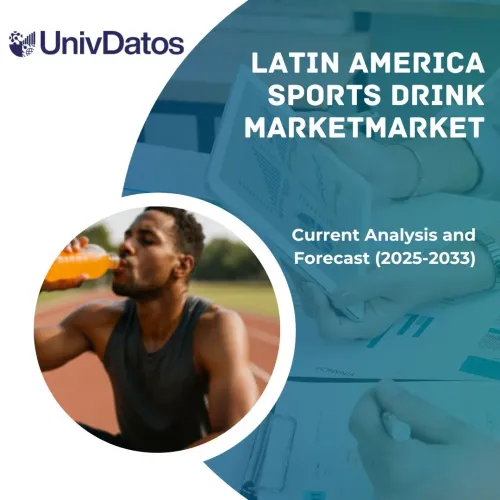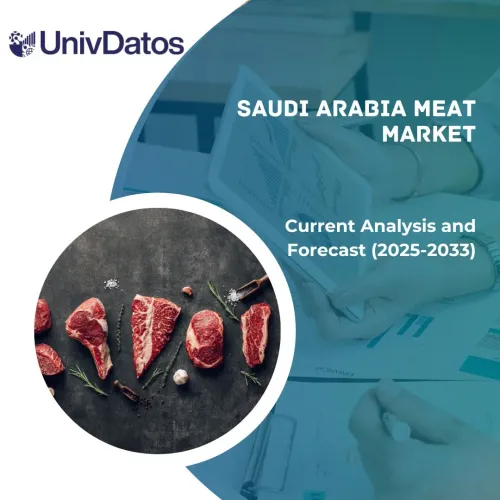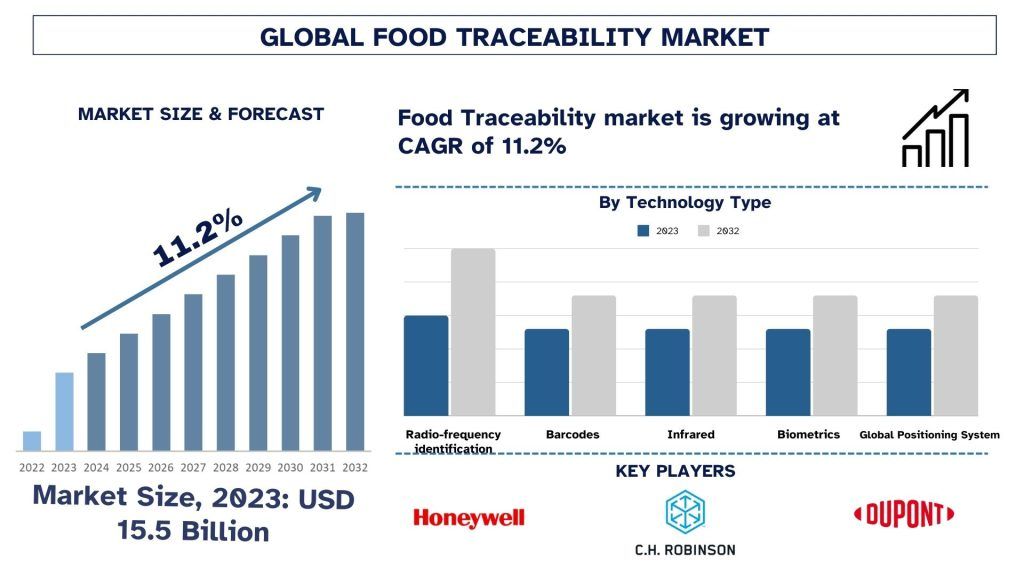
식품 추적성 시장 규모 및 예측
식품 추적성 시장은 2023년에 약 155억 달러로 평가되었으며 예측 기간(2024-2032) 동안 약 11.2%의 견조한 연평균 성장률(CAGR)로 성장할 것으로 예상됩니다. 이러한 추세는 고객 인식 및 수요 증가, 정부 및 산업 표준, 블록체인 및 IoT와 같은 디지털 혁신에 기반합니다.
식품 추적성 시장 분석
식품 추적성은 생산, 가공 및 유통을 포함하여 식품 공급망을 통해 식품의 흐름을 추적하고 식품 공급망의 어느 단계에서든 제품을 찾을 수 있도록 하는 시스템을 의미합니다. 빠르게 증가하는 식품 산업 수와 증가하는 식품 매개 질병 수는 식품 추적 가능 시장 성장에 기여하는 중요한 요소입니다. 예를 들어, WHO에 따르면 전 세계적으로 약 6억 명(거의 10명 중 1명)이 오염된 음식을 섭취한 후 병에 걸리고 매년 420,000명이 사망하여 3,300만 건강 수명년의 손실을 초래합니다. 또한, GM 작물의 사용 증가와 식품 재배를 위한 농경지에서의 화학 물질 사용 또한 시장 성장에 영향을 미칩니다.
식품 추적성 시장 동향
이 섹션에서는 당사 연구 전문가가 파악한 식품 추적성 부문에 영향을 미치는 주요 시장 동향에 대해 설명합니다.
산업을 변화시키는 바코드 부문
기술 유형에 따라 시장은 무선 주파수 식별, 바코드, 적외선, 생체 인식 및 글로벌 포지셔닝 시스템으로 분류되었습니다. 이 중에서 바코드 부문은 식품 추적성 시장에서 상당한 점유율을 차지하고 있습니다. 바코드를 통해 작업 진행 상황 추적 또는 자산 이동을 더 빠르고 정확하게 수행하여 정보의 더 빠르고 정확한 전송 및 기록이 가능합니다. 또한 제품 관리 및 품질 검사에서 식품 제조 공장을 지원합니다. 따라서 식품 추적성 시장에서 해당 부문의 시장 규모가 증가하고 있습니다.
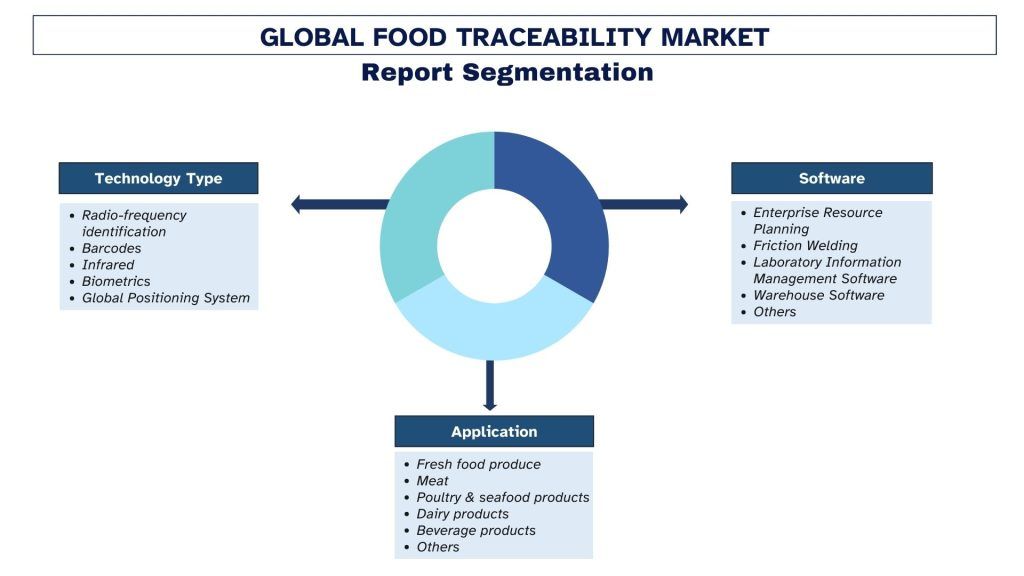
아시아 태평양이 시장에서 상당한 점유율을 차지할 것
2023년에는 아시아 태평양이 전 세계 식품 추적성 시장에서 가장 빠른 성장을 보일 것으로 예상됩니다. 이 지역의 구매력 상승과 인구 밀도 증가는 이 지역의 식품 산업 성장에 영향을 미치는 중요한 요인 중 하나입니다. 또한, 인구의 건강 식품 소비에 대한 인식이 높아지는 것도 식품 추적성 시장의 지역 성장에 중요한 요인입니다.
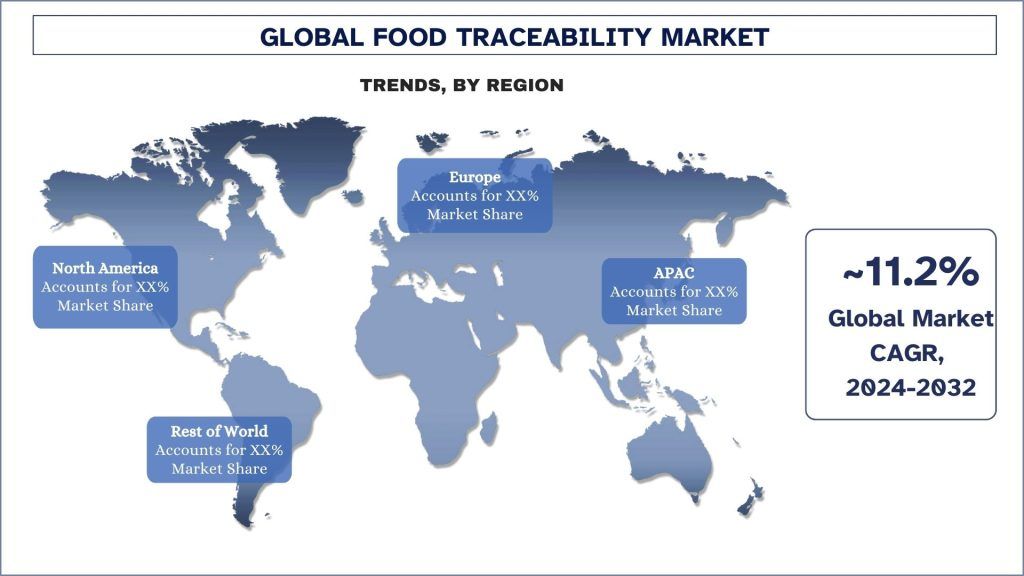
식품 추적성 산업 개요
식품 추적성은 여러 글로벌 및 국제 시장 참여자가 있는 경쟁적인 시장입니다. 주요 업체들은 파트너십, 계약, 협업, 신제품 출시, 지리적 확장, 인수합병 등 시장 입지를 강화하기 위해 다양한 성장 전략을 채택하고 있습니다. 시장에서 활동하는 주요 업체로는 Honeywell International Inc, C.H. Robinson Inc, DuPont Nutrition and Biosciences, Bio-Rad Laboratories, IdentiGEN, IBM Corporation, Intertek Group, Cognex Corporation, MASS Group, Zebra Technologies 등이 있습니다. 이러한 업체들은 고객에게 첨단 혁신적인 제품/기술을 제공하기 위해 여러 건의 M&A 및 파트너십을 체결했습니다.
최근 개발
- 2024년 1월, SpartanNash는 공급망의 안전성과 투명성을 강화하기 위한 추적성 프로그램을 도입하기 위해 ReposiTrak과 파트너십을 발표했습니다. 이 이니셔티브를 통해 미국 식품의약국이 식품 추적성을 위해 나열한 제품의 수확 또는 취급에 관련된 수백 명의 공급업체는 SpartanNash와 도매 고객에게 추적성 데이터를 제공해야 합니다.
식품 추적성 시장 보고서 범위
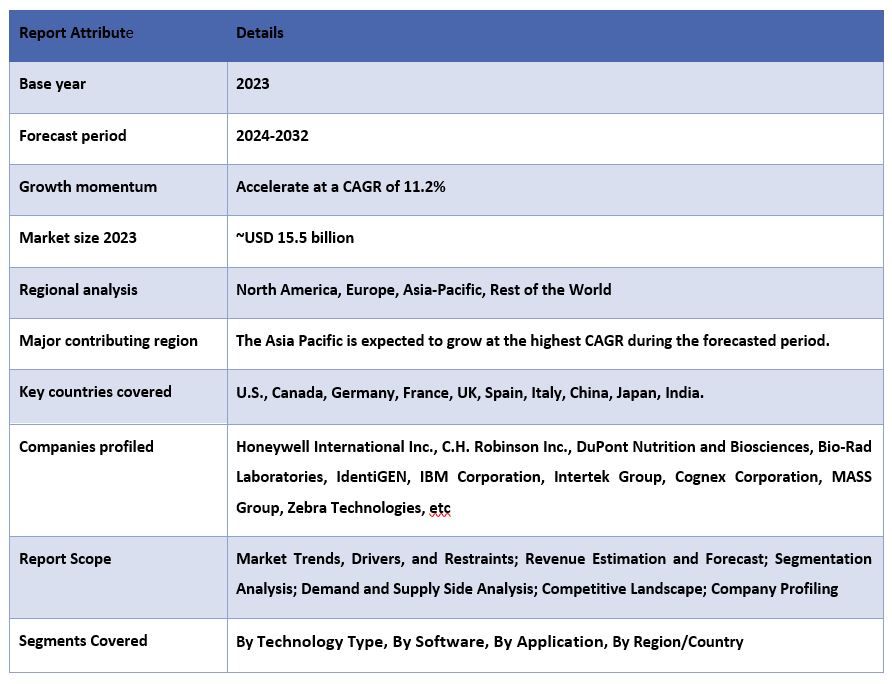
본 보고서를 구매해야 하는 이유:
- 본 연구에는 인증된 주요 산업 전문가가 검증한 시장 규모 측정 및 예측 분석이 포함되어 있습니다.
- 본 보고서는 전체 산업 성과에 대한 간략한 개요를 제공합니다.
- 본 보고서는 주요 비즈니스 재무, 제품 포트폴리오, 확장 전략 및 최근 개발에 중점을 두고 주요 산업 동료에 대한 심층적인 분석을 다룹니다.
- 산업 전반에 걸쳐 널리 퍼져 있는 동인, 제약, 주요 동향 및 기회에 대한 자세한 검토.
- 본 연구는 다양한 부문에 걸쳐 시장을 포괄적으로 다룹니다.
- 산업에 대한 심층적인 지역 수준 분석.
맞춤화 옵션:
글로벌 식품 추적성은 요구 사항 또는 기타 시장 부문에 따라 추가로 맞춤화할 수 있습니다. 이 외에도 UMI는 귀하가 고유한 비즈니스 요구 사항을 가지고 있을 수 있음을 이해하므로 귀하의 요구 사항에 완벽하게 맞는 보고서를 얻으려면 언제든지 당사에 문의하십시오.
목차
식품 추적성 시장 분석 (2022-2032)을 위한 연구 방법론
글로벌 식품 추적성 시장의 과거 시장 분석, 현재 시장 추정, 미래 시장 예측은 전 세계 주요 지역에서 식품 추적성 도입을 생성하고 분석하기 위해 수행된 세 가지 주요 단계였습니다. 과거 시장 수치를 수집하고 현재 시장 규모를 추정하기 위해 철저한 2차 연구가 수행되었습니다. 둘째, 이러한 통찰력을 검증하기 위해 수많은 결과 및 가정이 고려되었습니다. 또한, 글로벌 식품 추적성 시장의 가치 사슬 전반에 걸쳐 업계 전문가와 함께 광범위한 1차 인터뷰도 진행되었습니다. 1차 인터뷰를 통해 시장 수치를 가정하고 검증한 후, 전체 시장 규모를 예측하기 위해 하향식/상향식 접근 방식을 사용했습니다. 그 후, 시장 세분화 및 데이터 삼각 측량 방법을 채택하여 산업의 세분 시장 및 하위 세분 시장의 시장 규모를 추정하고 분석했습니다. 자세한 방법론은 아래에 설명되어 있습니다.
과거 시장 규모 분석
1단계: 2차 출처에 대한 심층 연구:
연례 보고서 및 재무 제표, 실적 발표, 보도 자료 등과 같은 회사 내부 출처와 저널, 뉴스 및 기사, 정부 간행물, 경쟁사 간행물, 부문 보고서, 타사 데이터베이스 및 기타 신뢰할 수 있는 간행물을 포함한 외부 출처를 통해 식품 추적성 시장의 과거 시장 규모를 확보하기 위해 자세한 2차 연구가 수행되었습니다.
2단계: 시장 세분화:
식품 추적성의 과거 시장 규모를 확보한 후, 주요 지역의 다양한 세분 시장 및 하위 세분 시장에 대한 과거 시장 통찰력과 점유율을 수집하기 위해 자세한 2차 분석을 수행했습니다. 주요 세분 시장은 기술 유형, 소프트웨어, 애플리케이션 및 지역과 같이 보고서에 포함되어 있습니다. 또한 해당 지역의 테스트 모델의 전체 채택을 평가하기 위해 국가 수준 분석을 수행했습니다.
3단계: 요인 분석:
다양한 세분 시장 및 하위 세분 시장의 과거 시장 규모를 확보한 후 식품 추적성 시장의 현재 시장 규모를 추정하기 위해 자세한 요인 분석을 수행했습니다. 또한 기술 유형, 소프트웨어, 애플리케이션 및 식품 추적성 지역과 같은 종속 변수와 독립 변수를 사용하여 요인 분석을 수행했습니다. 전 세계 식품 추적성 시장 부문에서 상위 파트너십, 인수 합병, 사업 확장 및 제품 출시를 고려하여 수요 및 공급 측면 시나리오에 대한 철저한 분석을 수행했습니다.
현재 시장 규모 추정 및 예측
현재 시장 규모 측정: 위의 세 단계에서 얻은 실행 가능한 통찰력을 바탕으로 현재 시장 규모, 글로벌 식품 추적성 시장의 주요 업체 및 세분 시장의 시장 점유율에 도달했습니다. 필요한 모든 백분율 점유율 분할 및 시장 분석은 위에 언급된 2차 접근 방식을 사용하여 결정되었으며 1차 인터뷰를 통해 검증되었습니다.
추정 및 예측: 시장 추정 및 예측을 위해 동인 및 추세, 제약 및 이해 관계자에게 제공되는 기회를 포함한 다양한 요인에 가중치가 할당되었습니다. 이러한 요인을 분석한 후 관련 예측 기술, 즉 하향식/상향식 접근 방식을 적용하여 전 세계 주요 시장에서 다양한 세분 시장 및 하위 세분 시장에 대한 2032년 시장 예측에 도달했습니다. 시장 규모를 추정하기 위해 채택된 연구 방법론은 다음과 같습니다.
- 수익(USD) 측면에서 업계의 시장 규모와 국내 주요 시장에서 식품 추적성 채택률
- 시장 세분 시장 및 하위 세분 시장의 모든 백분율 점유율, 분할 및 분석
- 제공되는 제품 측면에서 글로벌 식품 추적성의 주요 업체. 또한 빠르게 성장하는 시장에서 경쟁하기 위해 이러한 업체가 채택한 성장 전략
시장 규모 및 점유율 검증
1차 연구: 주요 지역의 최고 경영진(CXO/VP, 영업 책임자, 마케팅 책임자, 운영 책임자, 지역 책임자, 국가 책임자 등)을 포함한 주요 오피니언 리더(KOL)와 심층 인터뷰를 진행했습니다. 그런 다음 1차 연구 결과를 요약하고 명시된 가설을 증명하기 위해 통계 분석을 수행했습니다. 1차 연구의 입력은 2차 결과와 통합되어 정보를 실행 가능한 통찰력으로 전환했습니다.
다양한 지역의 1차 참가자 분할
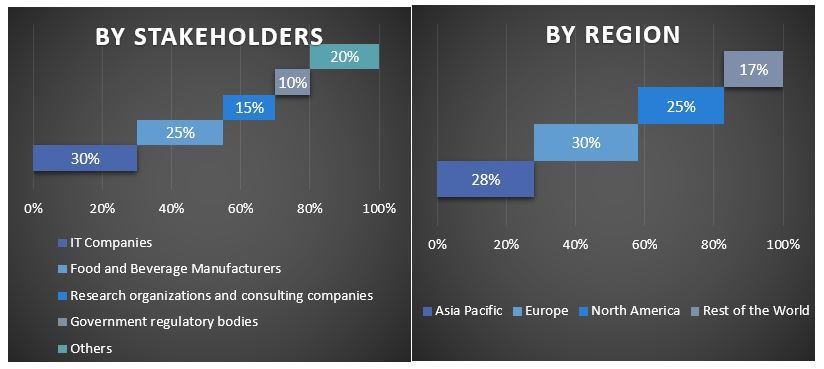
시장 엔지니어링
전반적인 시장 추정을 완료하고 글로벌 식품 추적성의 각 세분 시장 및 하위 세분 시장에 대한 정확한 통계 수치에 도달하기 위해 데이터 삼각 측량 기술이 사용되었습니다. 데이터는 글로벌 식품 추적성 시장의 기술 유형, 소프트웨어, 애플리케이션 및 지역의 다양한 매개변수와 추세를 연구한 후 여러 세분 시장 및 하위 세분 시장으로 분할되었습니다.
글로벌 식품 추적성 시장 조사의 주요 목표
글로벌 식품 추적성의 현재 및 미래 시장 동향이 연구에서 정확히 지적되었습니다. 투자자는 연구에서 수행된 정성적 및 정량적 분석에 대한 투자 재량권을 확보하기 위해 전략적 통찰력을 얻을 수 있습니다. 현재 및 미래 시장 동향은 지역 수준에서 시장의 전반적인 매력을 결정하여 산업 참가자가 미개척 시장을 활용하여 선점자 이점의 혜택을 누릴 수 있는 플랫폼을 제공했습니다. 연구의 다른 정량적 목표는 다음과 같습니다.
- 가치(USD) 측면에서 식품 추적성 시장의 현재 및 예측 시장 규모를 분석합니다. 또한 다양한 세분 시장 및 하위 세분 시장의 현재 및 예측 시장 규모를 분석합니다.
- 연구의 세분 시장에는 기술 유형, 소프트웨어, 애플리케이션 및 지역 영역이 포함됩니다.
- 식품 추적성에 대한 규제 프레임워크를 정의하고 분석합니다.
- 다양한 중개인의 존재와 관련된 가치 사슬을 분석하는 동시에 업계의 고객 및 경쟁자 행동을 분석합니다.
- 주요 지역에 대한 식품 추적성 시장의 현재 및 예측 시장 규모를 분석합니다.
- 보고서에서 연구된 지역의 주요 국가에는 아시아 태평양, 유럽, 북미 및 기타 지역이 포함됩니다.
- 식품 추적성 시장의 회사 프로필과 빠르게 성장하는 시장에서 생존하기 위해 시장 참여자가 채택한 성장 전략.
- 업계에 대한 심층적인 지역 수준 분석
자주 묻는 질문 자주 묻는 질문
Q1: 전 세계 식품 추적성 시장의 현재 규모와 성장 잠재력은 어떻게 되나요?
Q2: 전 세계 식품 추적성 성장의 주요 동인은 무엇입니까?
Q3: 기술 유형별 글로벌 식품 추적성 시장에서 가장 큰 점유율을 차지하는 부문은 무엇입니까?
Q4: 글로벌 식품 추적성 분야의 새로운 기술과 트렌드는 무엇인가요?
Q5: 어느 지역이 전 세계 식품 추적성 시장을 지배할 것인가?
관련 보고서
이 상품을 구매한 고객님들도 함께 구매하신 상품


